3 top guitar pedal makers on the secrets of truly great gain tone
We asked the experts to share their guitar tone tips - and some common pitfalls to avoid

If you want to really get inside the soul of a guitarist, start talking to them about how they like their drive tones. Some players want crystalline projection and clarity, others a swampy mudslide of saturated fuzz.
Every player’s sweet spot is different when it comes to gain and, to make things more interesting, that perfect lead tone is the sum of several tonal influences - with pedals, amp and the player themselves at the heart of the equation.
Marshalling all those elements to produce the tone you want, everytime, no matter the venue or musical task to hand, is a tough job. And, as in all things, knowledge is power.
So we called on the combined knowledge of three of the wisest heads in the drive tone business: Adrian Thorpe of Thorpy FX, Wampler's Brian Wampler and Daniel Steinhardt of TheGigRig and That Pedal Show.
Here, they give their seasoned tips on how to make your gain tones more nuanced and expressive than ever - and dodge some common pitfalls that can spoil the gig.

Following his full army career, Major Adrian Thorpe MBE first began building pedals as a form of relaxation that also allowed him to have the best pedals around. Now that passion has turned into Thorpy FX with a mission to produce the best sounding, most robust and most beautiful guitar effects available.

Brian Wampler, CEO of Wampler Pedals, started oiut by tweaking pedals that were already on the market for his personal use. When these didn't cut the mustard, he started designing and producing his own brand new designs. The end result is renowned FX firm Wampler Pedals.

Daniel Steinhardt is widely known amongst tone aficionados as founder, owner, managing director and all-round Head Honcho of The Gig Rig and co-host of hugely popular YouTube channel That Pedal Show.
Q: I can dial in my drive pedals and amp to sound perfect together at home. But at rehearsals or gigs it all sounds wrong again. What’s going on?
Get your EQ right at proper gig volume, or all that top end is going to cut the audience’s heads off
A: “You need to EQ your amp and your rig to that particular environment,” Adrian Thorpe of Thorpy FX explains. “Typically, if you’re running louder - usually the case at rehearsals or gigs - you’ll need to lower your treble and upper mids as well, just to make sure your tone is not a scythe that cuts through the audience.
Want all the hottest music and gear news, reviews, deals, features and more, direct to your inbox? Sign up here.
"Treble and mids can get harsh at higher volumes, which is to do with Fletcher-Munson curves and how your ear perceives certain frequencies at certain decibel levels. At higher volumes, your speaker is in its optimum zone as well: it is just pumping out the decibels and working at its most efficient, so it’s able to beam sound outwards very effectively.
“So if you’re running an amplifier really, really loud, firstly I would suggest you get someone in the band to go and stand where the punters are going to stand while you do a soundcheck. If you don’t get your EQ right at proper gig volume, with someone you trust standing where the audience will stand to help you dial it in, all that top end is going to cut the audience’s heads off.”
Q: Is it important to settle on what type of amp you like first, before building a pedalboard?
A: “Absolutely,” says Daniel Steinhardt, “because that’s the one thing that’s likely to be a constant in your rig - even the guitar is likely to change more often than the amp. So, first, you need to find an amplifier with a clean sound that you connect with - and I mean at proper volume levels. Once you have that, then you sculpt the pedals.
"Although it changes all the time, the four main gain pedals that I’ve got on my board are a Keeley Java Boost, an Analog Man Red Dot Sunface, a D&M Drive and a Kingsley Page. And that’s because I’m using a 60-watt Hamstead 1x12 combo and those combined together sound amazing. If I go to the AC30, though, I’ll opt for the King of Tone, the Crowther Hot Cake and the Plosive Treble Booster.
"That’s because I’ve spent enough time messing about with different amps and pedals to narrow down what works best, to my ear, with each of those amps.
“But in general if you choose the pedals first and then try to work out what kind of amp you really want, you’re going to waste time. First find the style of amp that you love and then you will find pedals that sound fantastic with it. If you really get the basic combination of guitar and amp right first, it’s going save you years of heartache and guesswork.”

Q: People talk about ‘clipping’ a lot in relation to drive pedals - what is it?
A: “It means the signal that’s coming from your guitar is amplified and then the very top and the bottom of the waveform are chopped [off ] so that it sounds like the smoothness has gone and a level of aggression has been applied to it,” Adrian Thorpe explains.
All the differences in the components that are supposed to be the same, has a cumulative effect on the final sound of a given pedal
“So the signal comes in and it goes into the clipping part of the drive pedal’s circuit. That circuit will only allow a certain amount of voltage through. Depending on the type of drive pedal you can have some that sound more open and big than others. Something like a Hermida Audio Zen Drive, for example, uses Schottky diodes.
"They clip in a ‘soft’ manner - they don’t let a lot of forward voltage through. Whereas something that’s more hard clipping might be a pair of LEDs: something like I use in the Gunshot overdrive. It lets more [voltage] through, but when it does clamp down, it clamps down quite hard.
“Effectively, what you’re trying to do is replicate within a pedal what’s happening within a valve. You’re trying to create distortion - and it does that through chopping your signal and making it more like a square wave than a sine wave.”

Q: People talk about the sound of various versions of the Tube Screamer but I can’t really hear any difference. Is it just more cork-sniffing myths?
A: While there are some differences between the various types of Tube Screamer, it should also be said that at least some of what people perceive as sounding ‘different’ when comparing variants of the same pedal can be put down to inconsistencies in common components.
Brian Wampler of Wampler effects explains: “Every component has a tolerance [degree to which its actual performance may differ from its published spec], whether it’s a capacitor, a diode, a resistor or a potentiometer.
"A resistor, for example, might influence how much gain a pedal is going to have. But the differences in tolerance from one resistor to the next means that Pedal A may end up with a different amount of gain to Pedal B, even if they are the same model and make of overdrive.
“Now apply that to all the parts that go to make a Tube Screamer, for example. The variability in the performance of its individual parts means you can end up with pedals that sound dramatically different, even though they are supposed to sound the same. At Wampler, we try to get around that by sourcing components that have lower tolerances.
"So instead of buying potentiometers that have a tolerance of plus-or-minus 20 per cent, because they’re cheaper potentiometers, we’ll find potentiometers that are as close to one per cent as we can get without having it be a $400 pedal. But to return to the main point, all those changes, all those differences in the performance of components that are supposed to be the same, has a cumulative effect on the final sound of a given pedal.”

Q: I love high-gain tones but I just can’t seem to get a really heavy sound that also has the clarity to cut through a mix. What am I doing wrong?
A: “The problem is you’ve only got so much signal,” explains Adrian Thorpe. “Within a pedal or a series of pedals you can raise the volume artificially using op amps and all the rest of it.
"However, what you end up doing when you make a high-gain sound - either by cascading gain stages or hard clipping - is chopping off the very top and the very bottom of the signal, which is very much what a compressor does. So by doing that you’re limiting the signal that’s going through and it isn’t going to punch through as much.
People can suffer problems with high-gain drive sounds because of a combination of the two factors: compression and poor EQ
“One thing you can do is EQ the thing properly. A lot of the time, players looking for a heavy sound just scoop the mids - and then they can’t be heard at all. So I think people can suffer problems with high-gain drive sounds because of a combination of the two factors: compression and poor EQ.
"However, if you EQ things properly you can still punch through with enough volume - as long as you’ve mids. Don’t equate a good metal tone to lack of mids. I actually don’t think the two marry up particularly well.
“If you want to be heard but also want to use a drive effect with scooped mids, what I think you should do is maybe lower the gain and run another contrasting pedal that’s got prominent mids, which fills it back in.
"That’s why a lot of heavy players use two or more amps that are EQ’d very, very differently. One amp will be scooped quite heavily and tuned for bass and treble. The other one will be tuned for mids.
"Together they sound huge.”
Q: A lot of the players with great lead tone play loud - why?
A: “All of my favourite guitar players are loud,” Daniel Steinhardt says. “A lot of people misunderstand what volume gives you. Perhaps I should really say my favourite guitar players are dynamic.
"If you listen to a sax player in a room by themselves and they give it some welly, that thing is loud. But that sax player can also dial it down and use dynamics - contrasts between loud and quiet playing - to play really softly too.
“As guitar players, we’re so used to just giving it everything all the time. But listen to Mike Landau or John Scofield - they’re some of the most dynamic players you’ll ever hear. And with plenty of volume on tap, you can get that full range of dynamics: you can pick harder and it’ll go wild or you can pick softly and it comes down to a whisper. So that’s really what volume affords you. Having volume doesn’t mean you’re going to be loud all the time - but it gives you dynamic range.”

Q: I’ve tried using overdrive pedals that my favourite players swear by - but none really suited me. Am I missing something?
A: “I’ve probably tried them all,” Adrian Thorpe says. “And I don’t think there’s any one that I couldn’t live without, because a lot of pedals effectively do the same thing. We tend to shop with our eyes and our hearts rather than our ears. I get it, it’s very difficult for guitarists to try every bit of gear that’s out there.
You almost need to treat pedals like buying a pair of shoes... If they don’t fit you, you’re in agony
“So the first thing people do is look on forums or in mags, look on Facebook and look at what their favourite players use. But you almost need to treat it like buying a pair of shoes. I know that sounds so boring, but they’ve really got to fit you. If they don’t fit you, you’re in agony.
"Whether it’s your ears that are in agony or the punters who come to listen to you are in agony, one way or the other you’re suffering. That’s the dullest analogy I can probably think of, but it’s true: treat your pedals like a pair of shoes and make sure they fit you.”
Q: Some drive pedals have actual valves in them as opposed to just transistors. What are the pros and cons of that?
A: “The most important one is the output impedance of the pedal,” says Daniel Steinhardt. “Often, with a valvepowered preamp-style pedal, the output impedance is quite high. So it doesn’t drive [the signal through] long lengths of cable very well.
"So what can happen is that you set your valve overdrive pedal up so it sounds really nice on its own, and then you switch on a delay pedal further down the signal chain (delay pedals typically have a really low output impedance, which restores a lot of ‘zing’ and brightness to the signal) and all of a sudden that wonderful warm, chewy drive sound becomes really hard and brittle sounding.
"An easy solve for that is putting a buffer directly after your valve-powered drive pedal. And you leave that buffer on all the time and then you just dial in the sound of the drive pedal to suit. Then when the delay comes on it won’t suddenly make the sound much brighter.”

Q: Tell us a ‘secret weapon’ overdrive trick that you can use to unlock great lead sounds
One really great trick is to use an overdrive pedal to turn down the volume of your amp,
Daniel Steinhardt
A: “One really great trick is to use an overdrive pedal to turn down the volume of your amp,” says Daniel Steinhardt. “What generally happens with an amplifier is if you turn it down at the input, you lose gain, right?
"So if you set the amp loud but then use something like a really nice-sounding OD-1 or something in front of it you can turn the level down on the pedal but have the gain up so that you decrease the level going to the amplifier but compensate for that with a bit of gain from the pedal. And then when you turn the pedal off the natural, full volume of the amp becomes a solo boost that really cuts through.”
Q: Some amps are billed as ‘pedal friendly’? What does that mean?
The flatter the EQ of the amp, the more likely it’s going to take a wide range of pedals well
A: “Amps of that kind are typically low-gain pedal platforms that are optimised to allow you to get most of your drive from your pedals instead of from the amp,” explains Adrian Thorpe. “And, in that scenario, the amp almost just acts as a power amp. Because if you’re going to get your drive sound from the pedals one answer is to use them with an amplifier that has as flat an EQ as possible.
"The flatter the EQ of the amp, the more likely it’s going to take a wide range of pedals well. The only problem with that is you have maybe a little bit of a lack of character.
“By contrast, if you’ve got a naturally dark-voiced amp you’re going to need to pair it with bright pedals - or at least you’re going to have to have the scope within the pedal to adjust the EQ to that level. I’ll give you the perfect example:
"I’ve got a Mesa Mark V and when I put it on the Mark II setting, it’s a very dark amplifier. I’ve also got a Tone Bender that’s just earpiercingly sharp. So the two together are absolutely incredible. Either on their own are, to me, useless. Some people love extremes but I like a good balanced EQ.”

Q: I’ve seen some players plug preamp pedals like the Kingsley Page directly into the return of their amp’s effects loop. Why?
A: “The way an effects loop works in an amplifier is as a bridge between the preamp stage and the power amp stage,” Daniel Steinhardt says. “Generally, the signal will go through your amp’s preamp stage, out to delay and reverb effects, and then back in to the power amp stage.
"But your amp’s preamp is designed a certain way and will sound a certain way - which is great, if that’s the only sound you want. But if you want a bit more flexibility, having preamp pedals on the ’board and then plugging them into the effects loop return lets you choose what kind of preamp sound you want.
Having preamp pedals on the ’board and then plugging them into the effects loop return lets you choose what kind of sound you want
“You might want a Dumble-style preamp for a certain song, for example, or a JTM45 style preamp. Some of these valve preamp pedals sound so good - especially when you have the preamp pedal on your ’board and then you have your delays and reverbs after that and that gets plugged into the amp’s effects loop return… Depending on how many preamp pedals you have on the ’board, you could have the equivalent of a three-channel amplifier at your feet.”
Q: I’ve noticed that many overdrives that are supposed to sound ‘amp-like’ feature JFETs. Why is that?
A: “What you’ve got within a normal amp’s valve network is cascading gain,” Adrian Thorpe explains. “The first half of the first preamp valve, will clip - in other words create distortion. That then cascades into the next section of the valve - and, again, that clips and distorts. So you end up with a complex sound as a result of this cascading process within a valve amp. Each section of the pre-amp effectively adds its own bit of flavour to the resulting sound.
“There are different ways of replicating that process in a pedal. Some designers use JFETs (Joint Field Effect Transistor) which is what happens in a valve amp, but what they can do is create cascading gain. One JFET passes onto the next JFET, which passes onto another JFET and so on.
"In fact, at one stage in the evolution of amps, transistors were supposed to replace valves because they use less voltage and have some other advantages. And ultimately you can, with a few tweaks, take a JFET and do a one-for-one replacement for a valve. In reality though, it just doesn’t sound quite the same.”

Q: I’ve heard it said that the best drive tones happen when an amp’s power valves are distorting, not just the smaller valves in the preamp stage. Is this true?
A: “Power valve clipping can add to the depth and complexity of your drive sounds,” Adrian Thorpe explains. “But only at the point where you’ve breached the normal operating range of the valve. In most amplifiers these days the preamp is designed to cascade gain.
"What you then want is your power amp to take that signal and project it clearly through your speakers. But if you’ve got power amp distortion, you’ve now got the same thing that’s happened in your pre-amp happening in your power amp as well.
You spend all this money on a good guitar, a good amp… and sometimes, if you use a generous amount of gain, you can’t even hear the sound of the guitar
“That means we’re back to this complexity thing: you’ve got preamp distortion and power amp distortion all mixed together and then pumping out of your speaker. That’s why people like it. It’s a mixture of all the harmonics, it’s a mixture of all the different types of signal clipping - and it sounds sweet to our ears. So when people say, ‘Is power amp clipping important?’ Yes, I reckon so for those classic rock sounds.
“The players of the 60s didn’t have a choice - they only had those amps, they didn’t have dedicated PAs at the time. They just cranked the amplifier and their power amp was definitely saturating and adding its own thing to the mix. When you put that on record that’s the sound we tend to like because they’re the classic songs. To get that you have to drive the power amp.”
Q: What lesson has long experience taught you about gain?
A: “One of the biggest ones for me is that just dialling back on the gain a little can make you sound much better,” says Daniel Steinhardt. “There are times, for sure, when loads of gain is really appropriate - like with fuzz. But you spend all this money on a good guitar, a good amp… and sometimes, if you use a generous amount of gain, you can’t even hear the sound of the guitar itself.
"So sometimes just dialling back on that a hair lets you hear some of the characteristics of the guitar come through. And you might find when you turn the gain down you have to work a little bit harder - once you’ve found that beautiful sound, you may have to work harder to get it to come through than if you had endless gain and sustain. But that can actually be a real gift, making you more thoughtful about your note choices, dynamics and all the rest of it.”
Jamie Dickson is Editor-in-Chief of Guitarist magazine, Britain's best-selling and longest-running monthly for guitar players. He started his career at the Daily Telegraph in London, where his first assignment was interviewing blue-eyed soul legend Robert Palmer, going on to become a full-time author on music, writing for benchmark references such as 1001 Albums You Must Hear Before You Die and Dorling Kindersley's How To Play Guitar Step By Step. He joined Guitarist in 2011 and since then it has been his privilege to interview everyone from B.B. King to St. Vincent for Guitarist's readers, while sharing insights into scores of historic guitars, from Rory Gallagher's '61 Strat to the first Martin D-28 ever made.

